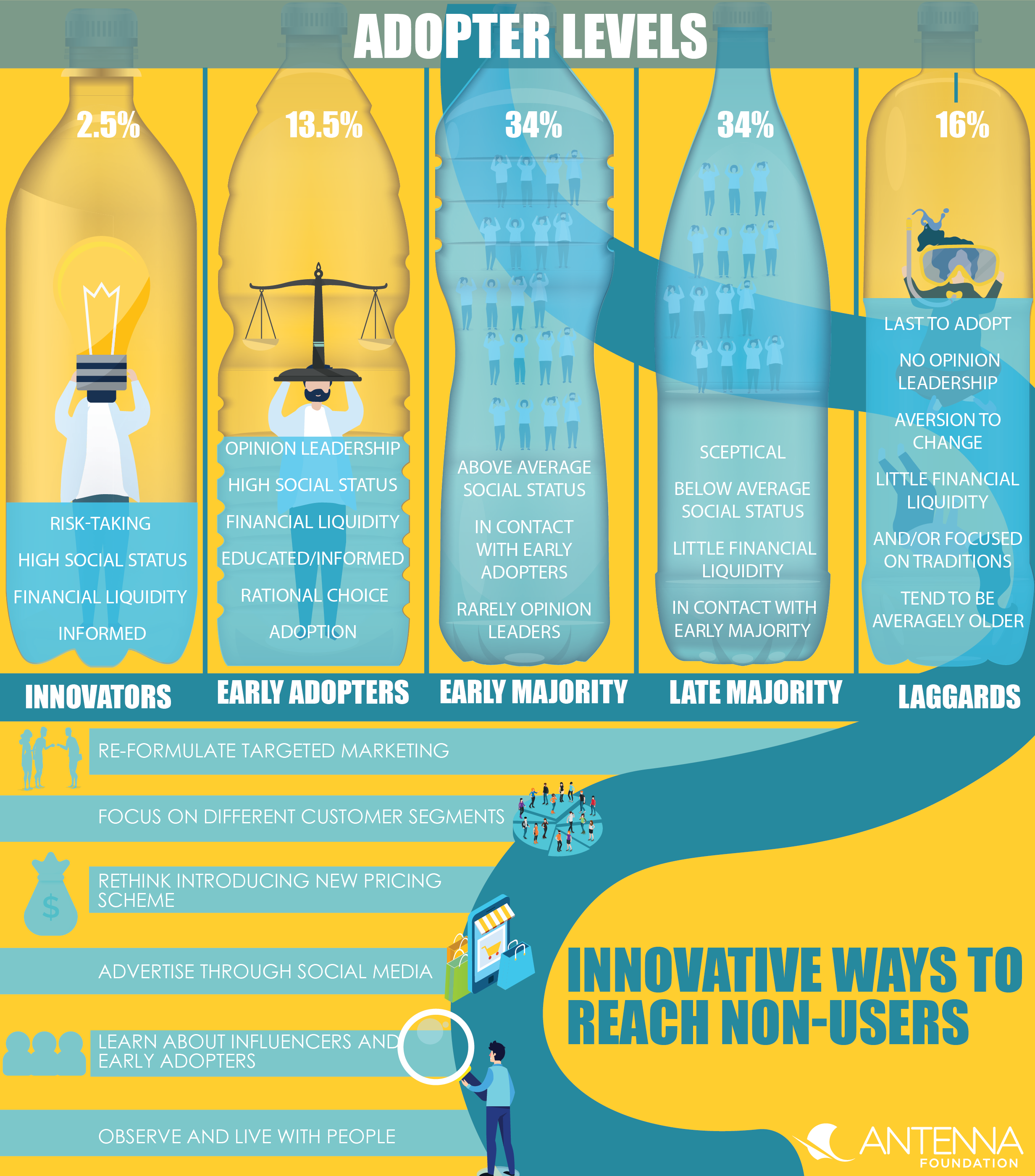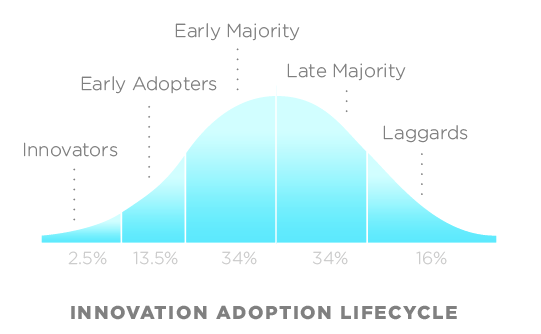Executive Summary

Creating innovative ways to reach non-consumers of safe water with household water treatment solutions (HWTS) or safe water services is challenging. This factsheet adapts the innovation adoption lifecycle to provide insights on how social processes can be understood and trusted people (influencers) within communities identified in order to reach non-users yet with novel and innovative safe water solutions.
The case study of Hydrologic in Cambodia provides insights on how decision makers have been identified in order to leverage and convince non-users in purchasing ceramic water filters.
What is reaching non-users all about?
Potential customers evaluate a novel product or service on its relative advantage (the perceived efficiencies gained by the innovation relative to current procedures or products they know and that are available), its compatibility with the pre-existing system, its complexity, its testability, and its observed effects (ROGERS, 2003). These qualities interact and are judged as a whole. Usually, a vast majority is rather sceptical about new products and services and will pay great attention to whether others adopt it or not (see graph below). Accordingly understanding social group processes when it comes to adopting novel and innovative HWTS and safe water services is one important factor in reaching non-users. Considering the adoption of innovation framework, depicting 5 adopter categories (see table below), from enthusiasts and early adopters to more conservative and sceptics, it is key to identify influencers in order to start the ball rolling.

Why to consider innovative ways to reach non-users?
The prevalence of waterborne diseases and scarcity of drinking water would suggest a high demand for potable water. And yet, most safe water businesses find in reality that they need to invest a lot into creating demand for safe drinking water in their market environment (see factsheet on social marketing). As most potential customers will have a myriad of reasons to not purchase products and services, from quality concerns over to perceiving little value added or cost issues. Culture, traditions and society structures play an important role in product acceptance. Accordingly, identifying innovative ways to reach non-users is key. Coupled with extensive awareness raising activities a variety of innovative approaches can help your safe water initiative to reach non-users (ROGERS, 2003; HALL ET AL., 2012).
Subscribe here to the new Sanitation and Water Entrepreneurship Pact (SWEP) newsletter. SWEP is a network of organizations joining hands to help entrepreneurs design and develop lasting water and sanitation businesses.
For whom is reaching non-users interesting?
To reflect about how to reach non-users is interesting for social safe water enterprises and NGOs who are starting out or thinking about entering new customer segments and/or geographies. But also safe water initiatives who are interested in reaching new customers in their existing market regions that are currently hesitant to purchase HWTS products or use safe water services. It is part of the inclusive business at the social level, not only witnessing that its product is for a certain type of consumers, but addressing also the BoP consumers that have not yet been reached (VAN DER KLEIN ET AL., 2012).
As for governments, this factsheet is also interesting to further understand how to better reach and integrate BoP consumers in the first economy. People do have a willingness and ability to pay for aspirational products and services, provided there are businesses to do so. And there is also the most vulnerable and poorest people that should be supported through educational schemes, smart subsidies (for further information please see factsheet on smart subsidies) and eventually pure philanthropy to allow them to move out of the poverty trap, as they have no access to markets yet (KRAAY & MCKENZIE, 2014).
How can non-users practically be reached?
Acquiring early adopters (also called lighthouse customers) is a common step in new product development and implementation. Innovators and lighthouse customers usually enjoy higher social status, and thus affect early and late majority adopters to follow purchases. In order to help identifying the different adopter levels, the subsequent characteristics will support you:
| Type | Characteristics |
|---|---|
| Innovators | Tangentially risk-taking, high social status, financial liquidity, informed |
| Early Adopters | Opinion leadership, social status, financial liquidity, educated/informed, judicious or rational choice for adoption |
| Early Majority | Above average social status, contact with early adopters, rarely opinion leaders |
| Late Majority | Sceptical, below average social status, little financial liquidity, tend to be in contact with late majority |
| Laggards | Last to adopt, no opinion leadership, aversion to change, little financial liquidity and/or focused on traditions, tend to be averagely older |
Characteristics of innovation adopters. Source: JESNOEWSKI, 2016; FRYKMAN, 2013
Important actions or processes that businesses can implement are numerous in order to reach non-users:
- Observe and live together with people in your target market and learn how social processes work in order to identify the early adopters and influencers (people with social status, opinion leaders, celebrities...). Get to know (inspiring methods can be found in the human centred design factsheet):
- Lifestyle and daily habits
- Preferences, desires and motivation
- Aspirations
- Group structures
- Learn about local preferences and characteristics of influencers and early adopters. Make comparisons with adopting similar products.
- Use social media platforms in order to advertise your products directly to your customer group. There are different ways to sell your product on social media (KASTELER, 2017; YEOMANS, 2012).
- Rethink introducing a new pricing scheme for specific customer segments (preferential pricing), terms and conditions of selling your product (marketing and sales strategy – for more information please see factsheet on sales process and value capture).
- Having identified how early adopters think about where like-minded people could be in order to increase sales.
- Knowing the reasons why non-users (initial and continuous customers) are not keen to buy safe water can help you to re-formulate targeted marketing campaigns towards them.
The case study of Hydrologic provides insights on how innovators were identified to leverage momentum in rural villages in Cambodia to convince BoP consumers purchasing and using ceramic water filters.
Entrepreneurship and Innovation at the Base of the Pyramid: A Recipe for Inclusive Growth or Social Exclusion?
Accelerating Customer Adoption at the Bottom of the Pyramid
How to identify your innovators and early adopters
Do Poverty Traps Exist?
Diffusion of Innovations
BoP Insights
Case Study - Copanor, Brazil
This paper examines the case of the government of Minas Gerais in Brazil and what innovative measures they used to reach people universally with access to water and sanitation in the rural and poorest region of the state.
DOS SANTOS ROCHA, W. SALVETTI, M. Case Study - Copanor, Brazil. Washington, DC : World Bank URL [Accessed: 16.04.2018] PDFAwareness in innovators: from ‘outside the box’ to ‘inside the bubble’
The authors discuss innovation in the context of ‘awareness’ and information available to customers. Flexible informational awareness accounts for both perceptions within the same overall innovation strategy is researched. A simple theoretical setup that yields an intuitive and tractable visualization - in the form of thought bubbles - for the process of innovation is proposed.
GOORHA, P. ; POTTS, J. (2016): Awareness in innovators: from ‘outside the box’ to ‘inside the bubble’. In: Journal of Global Entrepreneurship Research: Volume 6 URL [Accessed: 16.04.2018] PDFGoing to Scale with Safe Water: Analyzing the Business Model of Hydrologic Social Enterprise in Cambodia
The thesis focuses on various aspects of Hydrologic’s innovative business model and the different elements and difficulties in relation to Cambodia’s water sector. The author identifies strategies to scale up the company in another country and provides helpful, praxis-oriented insights into the development, the needs, the challenges and potentials of the company in the scaling process.
KOHLER, S. (2016): Going to Scale with Safe Water: Analyzing the Business Model of Hydrologic Social Enterprise in Cambodia. St.Gallen: University of St.Gallen URL [Accessed: 18.04.2018] PDF

